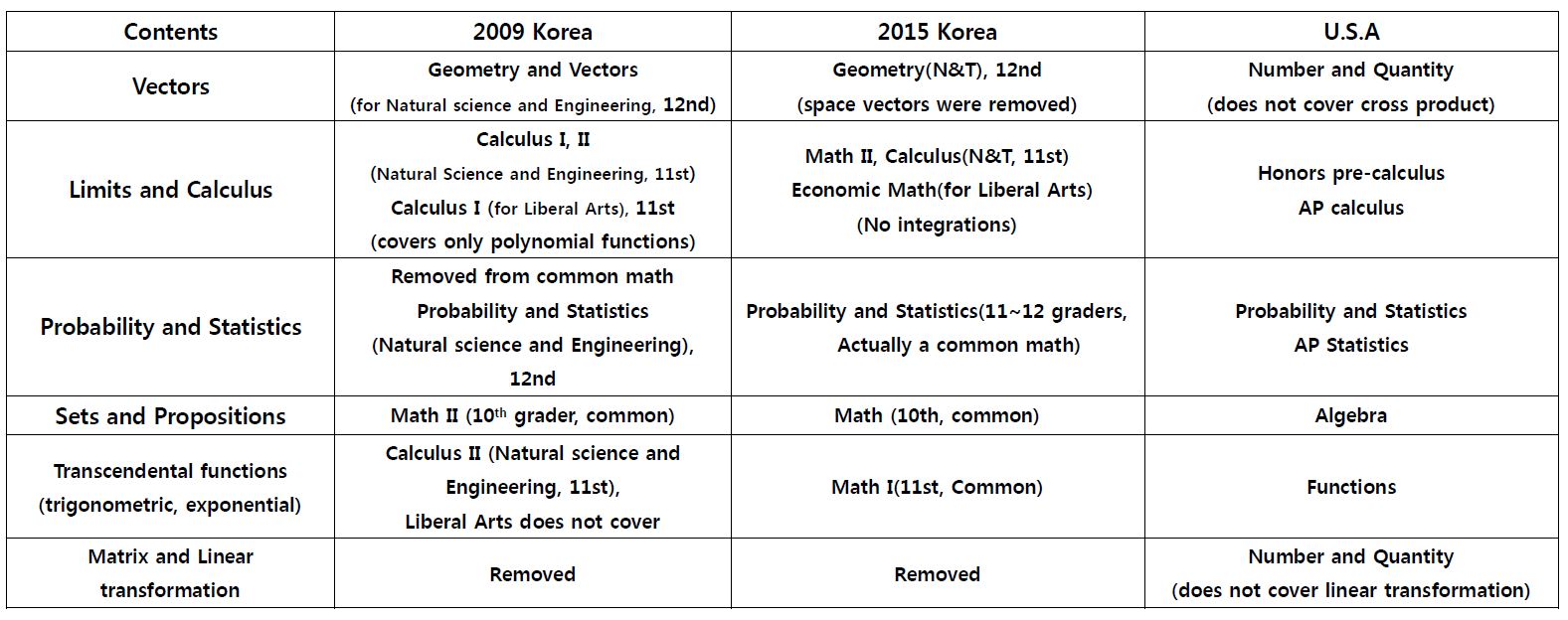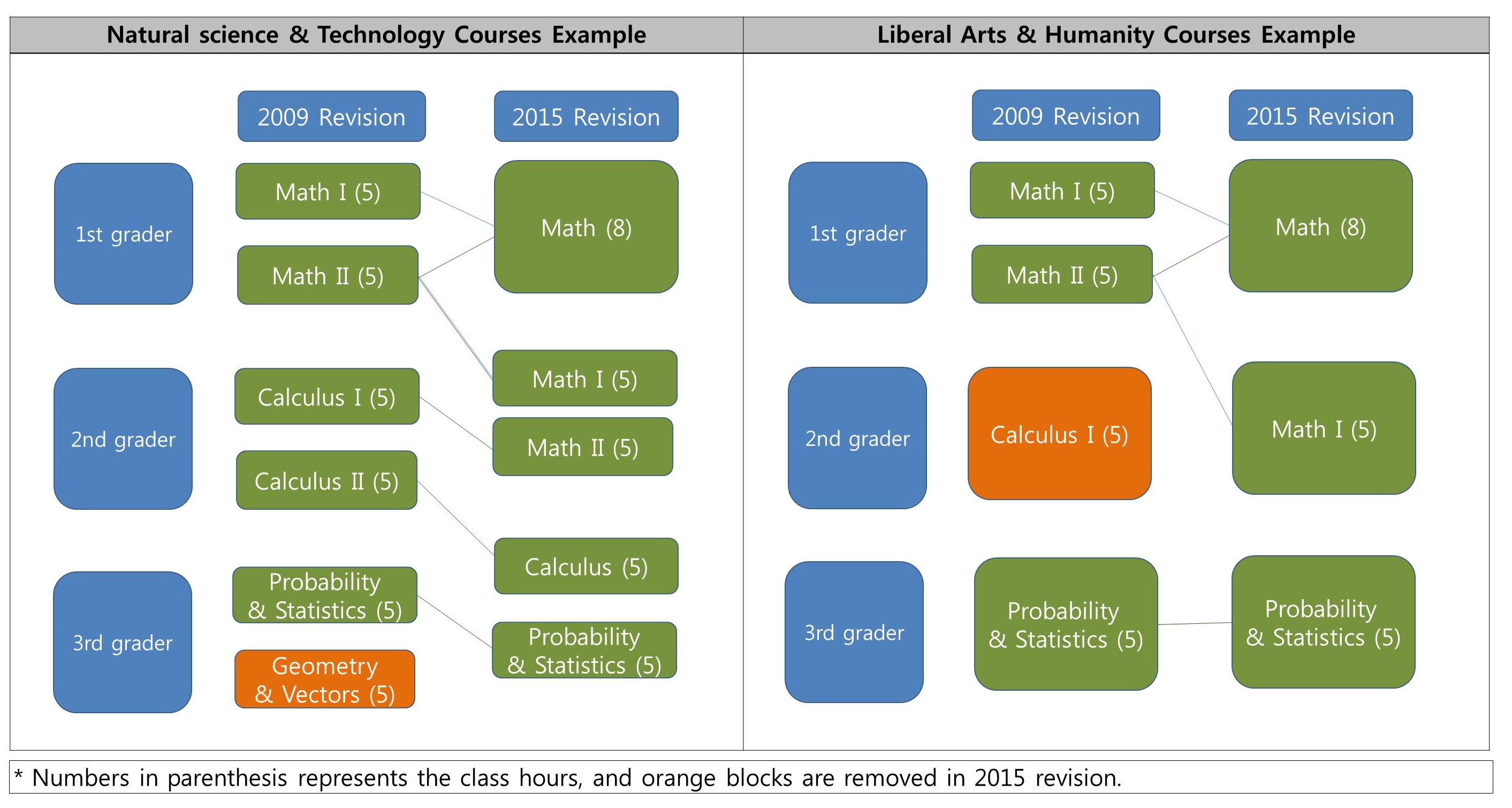

The Ministry of Education announced the “2015 Revision of Math Curriculum” on Sep. 23. Its key-word was “combination” between departments of natural science courses and liberal arts. The math curriculum has been reduced over the last few decades. In the revision of 1997, the Ministry of Education reduced 30% of the curriculum, and reduced 20% of the curriculum again in 2009. The 2015 revision was also set to reduce the curriculum. Ironically, this rather increased the curriculum for high school students of liberal arts. Because transcendental functions, probability, and statistics were added to the revised curriculum, which were not included in ordinary 2009 curriculum.
Also, calculus was removed from the list of essential courses, and moved to economical math. Hence, for students planning to major in liberal arts, studying calculus is not neccessary, unless they choose economical math as their optional course.
For students planning to attend natural sciences or engineering colleges, the curriculum as a whole did not change a lot. A notable change is the elimination of space vector, partition of natural number and set, and population ratio. Especially, removing space vector is expected to relieve the burden for students.
There are two opposite opinions about the current math education curriculum. It has been a bitter tug-of-war between autonomy and achievement. People with no concern about private education insist that the current math curriculum contains a lot of overlapped contents with university courses. They said teaching students calculus and other advanced concepts just increases students’ load.
On the other hand, the Korean Academy of Science and Technology (KAST) expressed its concerns about the reduced math curriculum in May 2015. KAST said reducing the curriculum does not reduce the use of private education. Rather, it brings maladjustment to freshmen. They pointed out that the Korean SAT and education policy must be reformed instead of a mere reduction in curriculum.
In US, the curriculum distinction between those planning to major in natural sciences or engineering and those in liberal arts does not seem as dramatic as it is in Korea. Instead, the curriculum attempts to achieve harmony among states. The US is composed of 50 different states. Traditionally, there have been discrepancies in mathematical curricula among states, so it was necessary to define what students should understand and be capable of doing after completing certain mathematical subjects. Thus, the mathematics curriculum in the US is focused on setting Common Core State Standards (CCSS) that are coherent enough that all 50 states can agree on them. The major purpose of CCSS for Mathematics is to fulfill its 8 mottos: making sense of problems and persevering in solving them, reasoning abstractly and quantitatively, constructing viable arguments and critiquing the reasoning of others, modeling with mathematics, using appropriate tools strategically, attending to precision, looking for and making use of structure, and looking for and expressing regularity in repeated reasoning. Under CCSS, mathematical subjects at secondary education levels fall into 6 major conceptual categories: Number and Quantity, Algebra, Functions, Modeling, Geometry, Statistics and Probability. Also, advanced placement (AP) courses and honors courses are available for those wishing to pursue a higher level of education in mathematics. AP courses include AP Calculus and AP Statistics. AP courses allow students to receive university credit before they enter university.
The major difference of the American style of curriculum is that it introduces concepts earlier but requires students to handle them repetitively and progressively throughout a number of school years. In contrast, the Korean style introduces a concept and requires students to complete it in one year. While this may maximize speed and efficiency in learning, if a student fails to grasp a portion of a concept at any moment, it may lead to him/her failing to understand the next portion of the concept and eventually making him/her give up understanding the whole concept.
Due to the difference of each country’s curriculum, Korean SAT and American SAT have totally different characteristics. Korean SAT is conducted once a year, but American SAT takes eight tests each year, and students can choose the highest score among the scores they got. Mathematics part of American SAT tends to inquire simple calcultation with calculator and concepts, while Korean SAT which requires high calculating problem ability without calculator and reasoning complicated problems. Korean SAT takes absolute proportion in university entrance, but in America, the percentage for SAT is only 20% to 30%, and the rest is filled with GPA, extracurricular activities, AP, and etc. However, SAT also faces a reform as a New SAT next year. Both countries keep putting their efforts into revising education curricula, to find the optimal way of education.
м Җмһ‘к¶Ңмһҗ © нҸ¬н•ӯкіөлҢҖмӢ л¬ё л¬ҙлӢЁм „мһ¬ л°Ҹ мһ¬л°°нҸ¬ кёҲм§Җ


